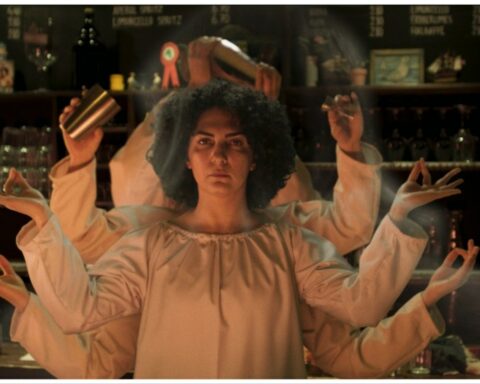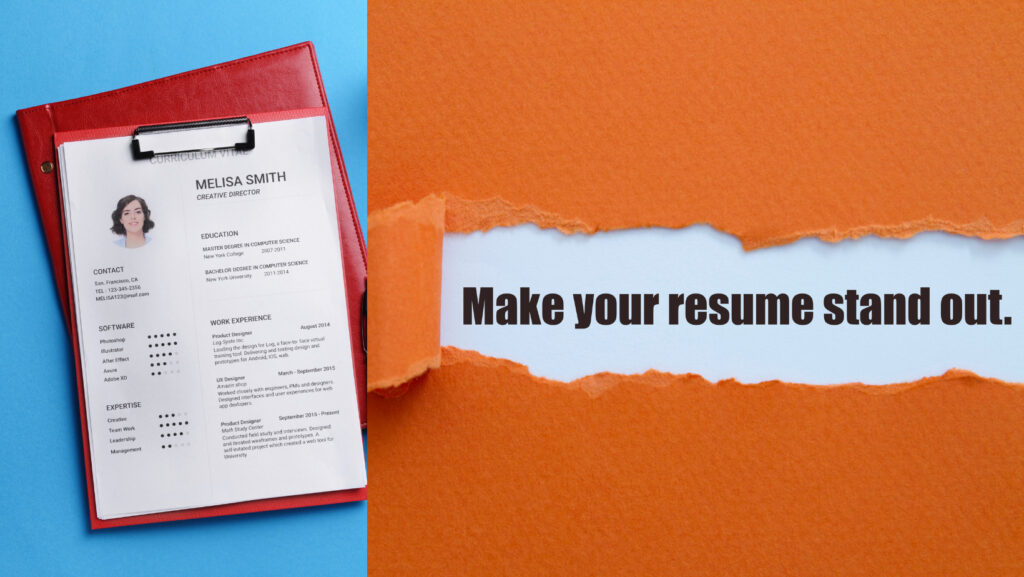
How To Make An Acting Resume
Are you an aspiring actor looking to take your career to the next level? Crafting a strong acting resume is crucial to landing your dream role. But with so many different acting resume templates available, it can be overwhelming to decide which one is right for you. That’s where this article comes in. We’ve compiled a list of the best acting resume templates to help you showcase your talent and stand out from the competition. Whether you’re a seasoned actor or just starting out, our expert tips and insights will guide you through the process of creating a professional and effective acting resume. So, let’s dive in and explore the world of acting resume templates together!
What Can You Put On An Acting Resume?
As with any job interview, a resume is always needed when going into an audition room. You will also need one when trying to get representation. An acting resume is like any resume except it is a resume that is specially tailored to your experience in the industry. A great acting resume is free to put together and should be something all professionals actors have handy. A well-made, well-formatted resume to casting agents, casting directors, and other industry professionals, is necessary to show your professionalism. This, in turn, increases your likelihood of getting hired for other jobs. Here is how to format an acting resume.
Basic Components of an Acting Resume
A. Contact Information
- The contact information section should be located at the top of the resume and include the actor’s full name, address, phone number, and email address.
- This section should be clear and easy to read so that casting directors and other industry professionals can quickly and easily reach out to the actor.
B. Physical Characteristics
- Including physical characteristics such as height, weight, hair and eye color, and clothing size can help casting directors find the best actor to play a particular character.
- This information should be listed after the contact information section.
C. Experience and Training
- This section should include information about the actor’s previous acting roles and any training or education they have received.
- It should be organized in reverse chronological order, starting with the most recent work or training experience and working backwards.
D. Special Skills
- The special skills section should list any unique skills or talents that the actor possesses, such as dancing, singing, or proficiency in a foreign language.
- This section should be located at the very bottom of the resume, below the experience and training section.
E. Headshot
- The headshot is a professional photograph of the actor that is included with the resume.
- It should be a high-quality image that accurately represents the actor’s appearance, and it should be placed at the top of the resume, either in the header or as a separate attachment.
Formatting An Acting Resume
A. Choosing a layout and font
- The layout of an acting resume should be clean, simple, and easy to read.
- The font should be a standard size and style, such as Times New Roman or Arial, and should be consistent throughout the resume.
- Use bold, italics, and underlining sparingly to emphasize important information.
B. Avoiding common mistakes
- Some common mistakes to avoid when formatting an acting resume include using multiple pages, including personal information such as age or social security number, and using a font that is difficult to read.
- The resume should be professional and polished, with no spelling or grammatical errors.
C. Tips for making your resume stand out
- Some tips for making an acting resume stand out include tailoring it to the specific role or project, using action verbs to describe previous experience, and including any special skills or unique qualifications.
- Organizing credits into three columns, including the name of the project, the size of the role, and the production company or director, can also make the resume easier to read and more professional.
- Including a brief personal statement or objective can help the resume stand out and showcase the actor’s passion and dedication to their craft.
By following these tips for formatting an acting resume, actors can present a professional and polished image to casting directors and increase their chances of being selected for auditions and roles.
Tailor the Resume to the Role
When creating an acting resume, it’s important to tailor it for each specific audition you apply to. This means customizing your resume to highlight the experience and skills that are most relevant to the particular role or production. Don’t just keep reusing the same generic copy. Updating the resume to the role and highlighting skills that are a good fit for it will help you stand out and show why you’re a great fit for that specific part. If you are going out for a theatrical role, make sure to list your theatrical experience before your film and tv experience. That is what that specific casting director is interested in.
To do this, you should carefully review the job description or breakdown and identify the key requirements and qualifications the casting directors are looking for. Then, you can adjust your resume accordingly, placing the most relevant information towards the top of the page.
In addition to tailoring your resume for each audition, it’s also a good idea to include a cover letter. This can be a brief but personalized message to the casting director or agent, explaining why you are interested in the project and why you are a good fit for the role.
By customizing your acting resume and including a thoughtful cover letter, you can make a strong impression on casting directors and increase your chances of getting called in for auditions.
Tips to Make Your Resume Stand Out
You now understand the basics of what to include in a resume and how to structure it. You might be wondering, though, what you can do to make it more interesting and attention-grabbing. Here are some bonus tips to keep in mind when you’re writing your resume:
Showcase Special Skills
Speaking of skills, be sure to showcase those that are relevant to a particular role. Do you speak a foreign language? Do you have experience with stunt work? If it seems like it’ll apply to the role, be sure to include it earlier in the skills section of your resume.
Personal Websites/Videos are Fine to Include
As a general rule, it’s fine to include your personal website but I would avoid adding links to videos of performances. Don’t go overboard on your resume. Remember, if your resume is saturated with links, it might feel unprofessional or as though you’re trying too hard.
Keep It Professional
Finally, be sure to keep your resume as professional and easy-to-read as possible. This means using a professional font like Times New Roman or Arial and spacing the information so that there’s a good amount of white space. Too little white space will make your resume look overwhelming (not in a good way) and may cause people to feel less interested in reading it. You should also proofread your resume (or better yet, have someone else proofread it for you). fIf the document is full of typos and grammatical errors, you’re going to have a hard time making a good first impression.
Acting Resume Templates
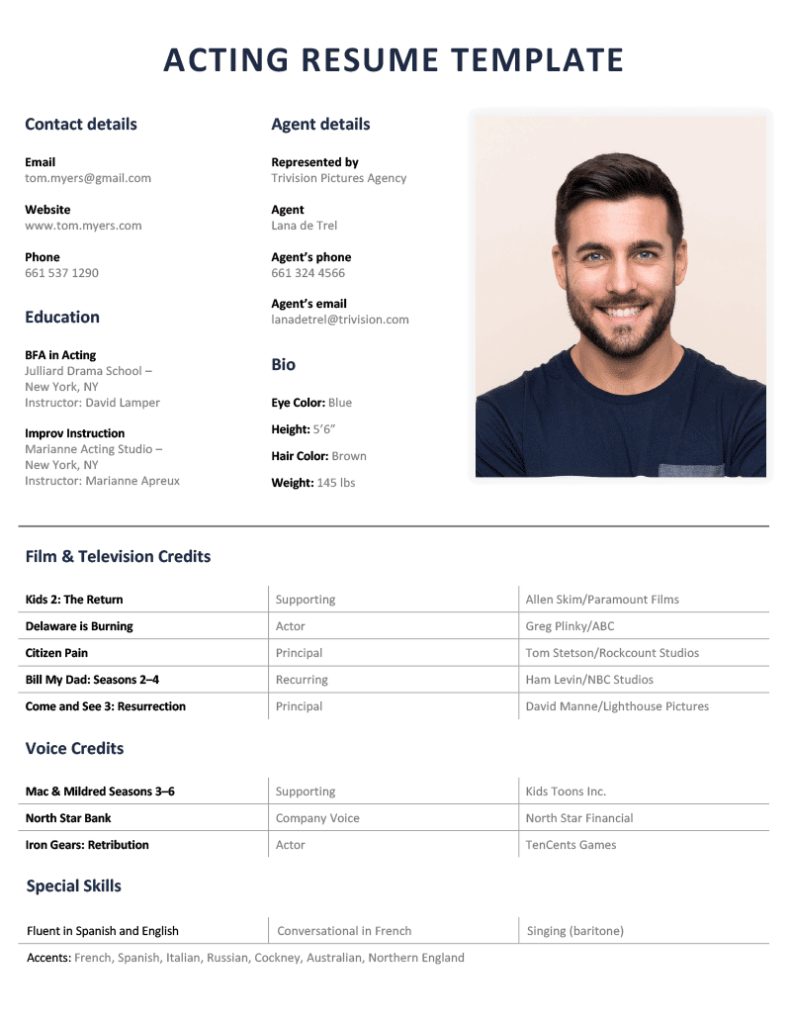
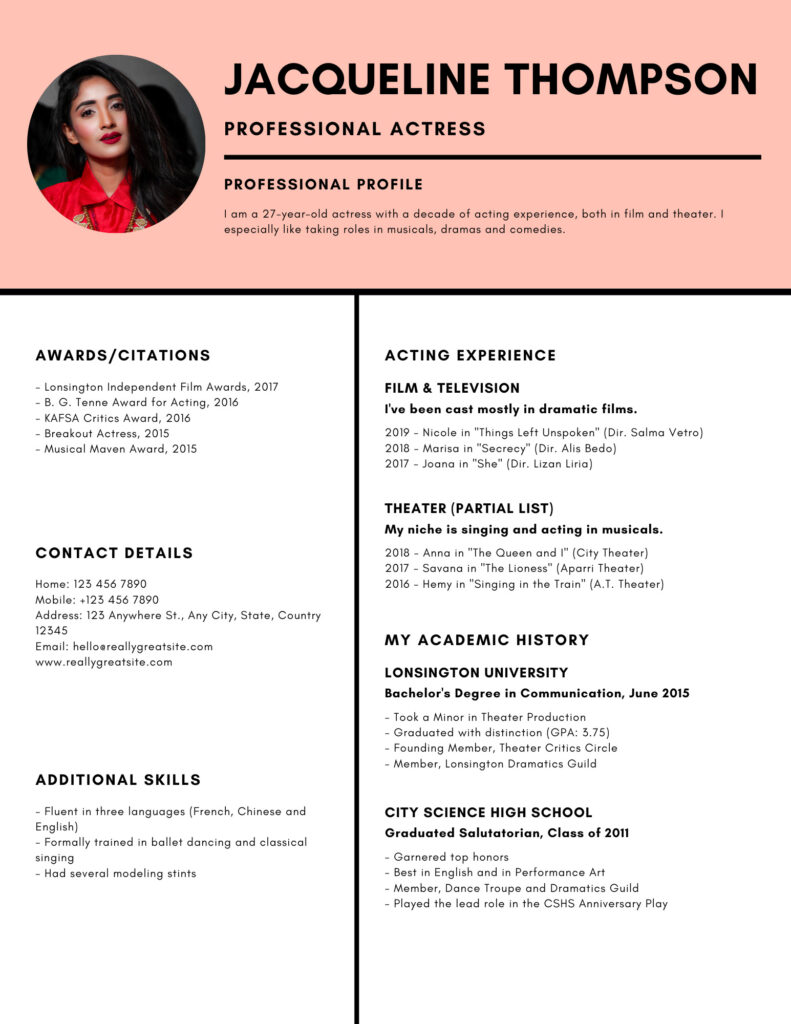
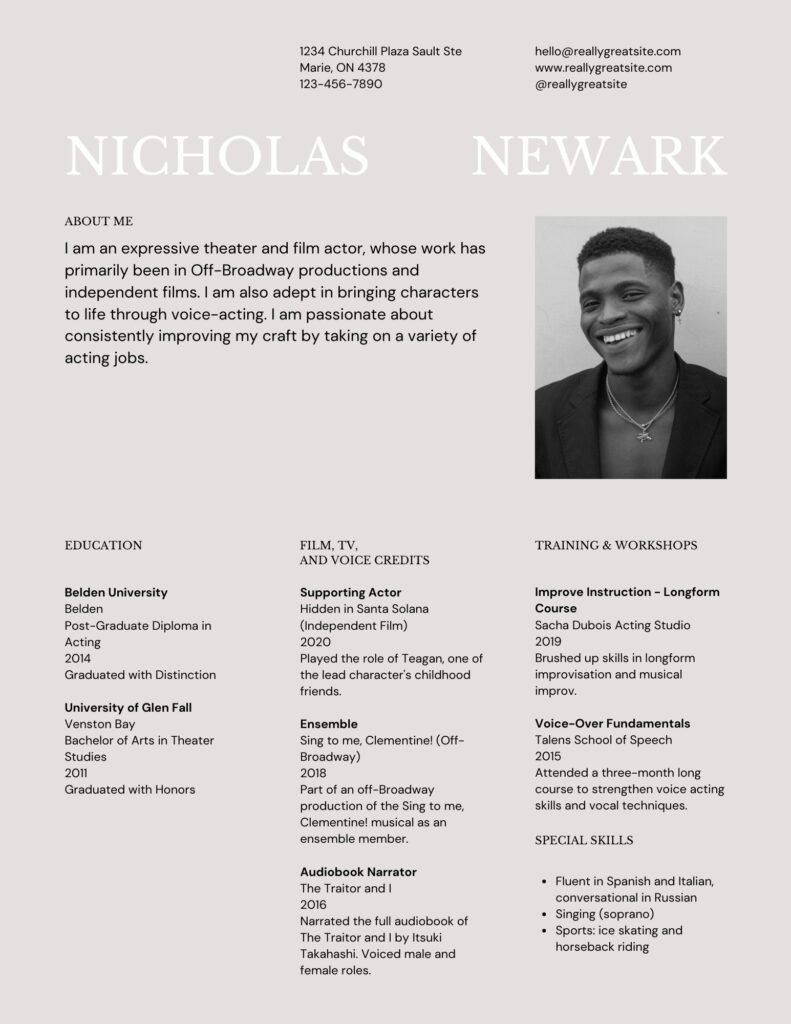
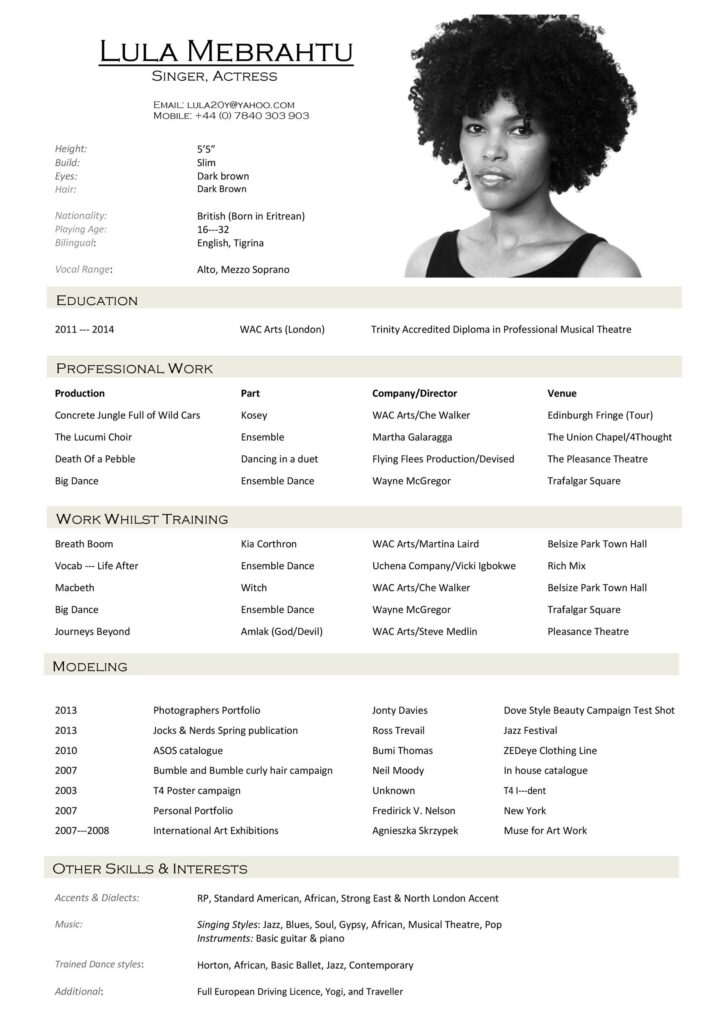
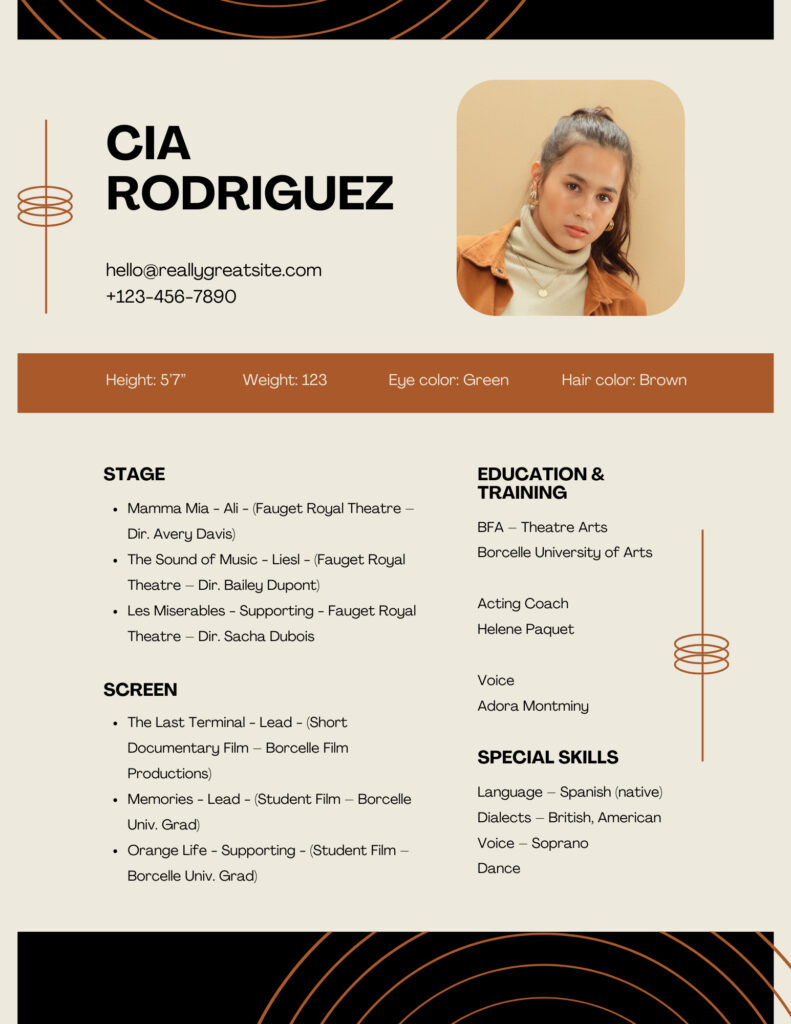
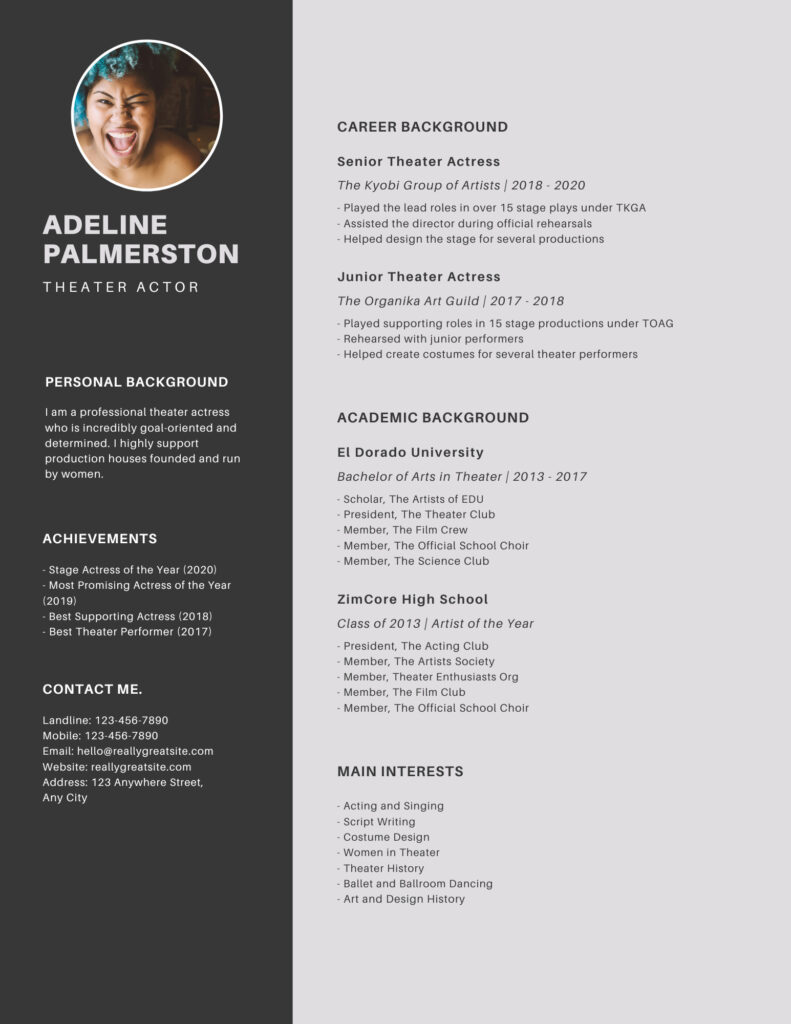
Obviously your resume will look different than the ones above depending on your credits and other information. But these are some great acting resume templates that you can use!
How Do I Make An Acting Resume With No Experience?
If you are an aspiring actor with little to no experience, it may seem daunting to create an acting resume that showcases your talent and potential. However, there are several tips and strategies you can use to make an effective resume even without prior acting experience. Here are some of the most helpful tips from the provided web search results:
- Start with a strong resume objective or summary: This should highlight what makes you perfect for the role and showcase any relevant education, workshops, or experiences that you have had in the performing arts industry.
- Add a headshot: A professional-looking headshot can help casting directors put a face to your resume and increase your chances of getting an audition.
- Add theater roles from school if you did stage plays while studying.
- List any previous roles you have had, even if they were not acting roles: This can include any roles you have had on a set or production, such as a production assistant or a stagehand.
- Include any training or education you have had in the performing arts: This can include acting workshops, classes, or even high school or college drama courses.
- Customize your resume to fit the role you are applying for: If you are auditioning for a specific role or project, tailor your resume to highlight any skills or experiences that are particularly relevant to that role.
By following these tips, you can create an effective acting resume that showcases your strengths and potential, even without prior experience in the industry.
Start Working on Your Acting Resume Today
Now that you’ve read through our tips on putting together an acting resume for beginners, it’s time to get to work. Follow the advice laid out above and you’ll have no trouble constructing an attention-grabbing resume that showcases your experience and shows everyone why you’re the best fit for the job.
Acting Resume Templates FAQs
1. Why use an acting resume template?
Acting resume templates can save you time and effort in formatting your resume. They can also help you ensure that your resume includes all the necessary information that casting directors and agents are looking for. With a template, you can focus on showcasing your skills and experience rather than worrying about design elements.
2. Should I use a different template for each audition?
It’s not necessary to use a different template for each audition, but you should customize your resume to match the specific requirements of each role you’re applying for. This might mean highlighting certain skills or experiences that are particularly relevant to the role.
3. Can I include a headshot on my acting resume template?
Yes, it’s common to include a headshot on an acting resume. In fact, many templates are designed to incorporate a headshot into the design. Just make sure that your headshot is professional and high-quality.
4. How Do I Build My Acting Resume
Your acting resume should be organized in reverse chronological order, with your most recent and relevant experience listed first. Be sure to include your contact information, physical characteristics, experience and training, special skills, and headshot.
5. Are there any common mistakes to avoid when using acting resume templates?
One common mistake is not tailoring your resume to the specific role you’re applying for. Make sure to relate your resume to the role by highlighting relevant experience and skills. Another mistake is not proofreading your resume for errors and typos. Finally, be careful when printing your resume on the back of your headshot to ensure that it’s cut to the correct size.







